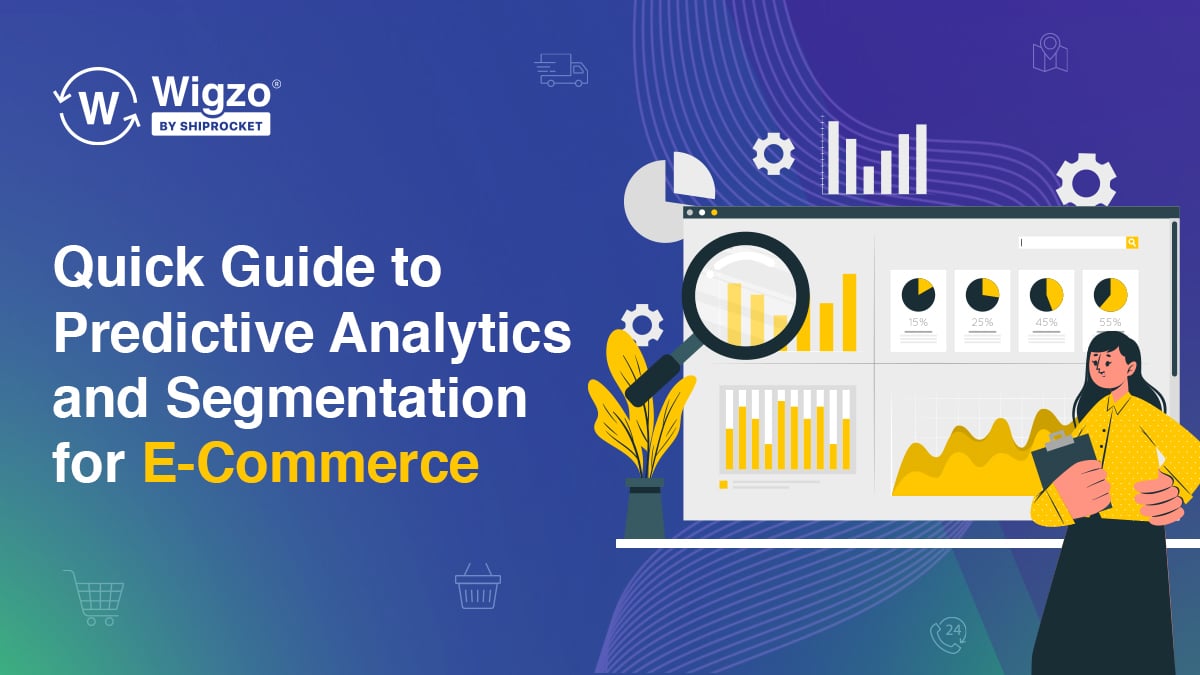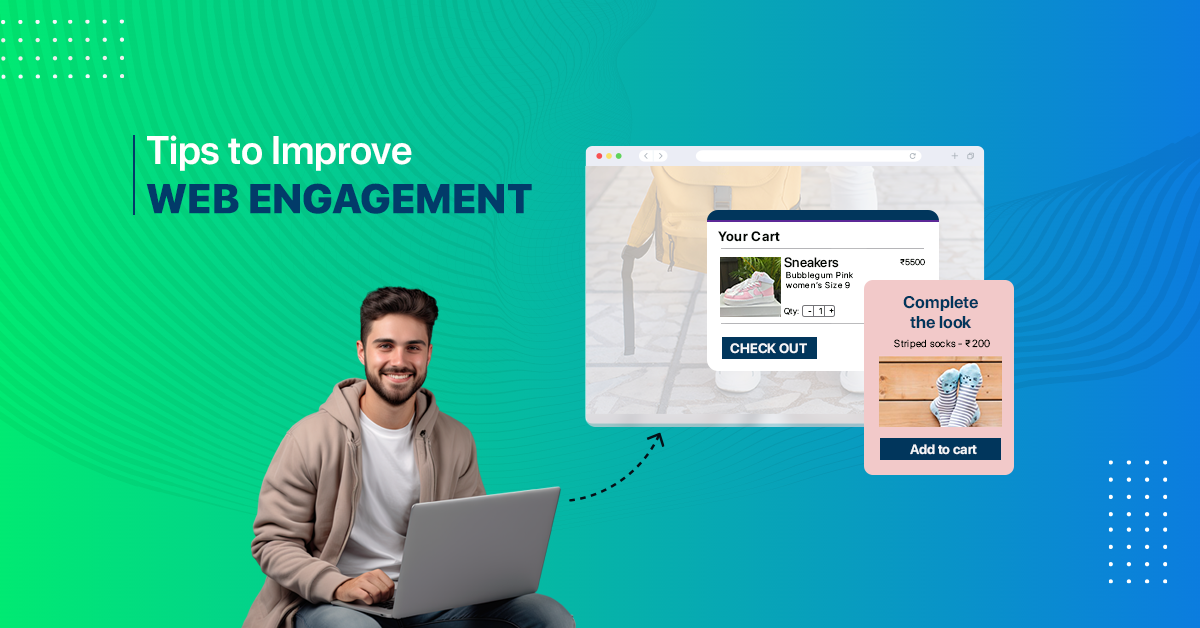Did you know that engaged customers are more likely to make repeat purchases, refer friends and family, and spend more money overall? In fact, a study by PwC found that customers who feel connected to a brand will spend up to 25% more on their purchases. It’s clear that tracking customer engagement is critical for e-commerce brands in India looking to build a loyal customer base and grow their business.
But what exactly are customer engagement metrics, and how can e-commerce brands use them to drive success? In this blog post, we’ll explore the top customer engagement metrics that e-commerce brands should be tracking to build stronger relationships with their customers and drive revenue.
We’ll cover metrics such as customer lifetime value (CLV), customer retention rate, and net promoter score (NPS) and explain why each metric is essential. We’ll provide real-world examples of how brands have used these metrics to improve engagement and drive revenue and discuss best practices for tracking and analysing each metric.
By the end of this post, you’ll have a deep understanding of how to use customer engagement metrics to build a successful e-commerce brand in India. So, let’s dive in and start cracking the code on customer engagement metrics!
Why do Customer Engagement Metrics Matter for e-commerce Success?
As an e-commerce brand in India, you know that building solid relationships with your customers is critical to driving success. But how do you know if you’re succeeding in this area? That’s where customer engagement metrics come in.
Customer engagement metrics are essential for several reasons. First and foremost, they give you a clear picture of how engaged your customers are with your brand. This information can help you identify which areas of your business resonate with your customers and which areas need improvement.
For example, let’s say you notice a decline in customer retention rate. By tracking this metric, you can pinpoint the problem and take action to address it. Perhaps your product quality has declined, or your customer service team isn’t meeting customer expectations. Customer engagement metrics can help you identify the issue and take steps to fix it.
By tracking key metrics such as customer lifetime value (CLV), customer retention rate, and net promoter score (NPS), e-commerce brands can better understand their customer’s needs and preferences.
CLV, for example, measures the total value of a customer to your business over the course of their relationship with your brand. Tracking this metric allows you to identify your most valuable customers and tailor your marketing efforts to their needs. Meanwhile, NPS measures how likely your customers are to recommend your brand to others. By tracking this metric, you can identify which aspects of your business are driving customer loyalty and which areas need improvement.
In the next section, we’ll dive into the top customer engagement metrics that e-commerce brands in India should be tracking. By understanding these metrics and how to measure them, you’ll be well on your way to building a successful e-commerce brand.
The Top Customer Engagement Metrics for e-commerce Success
To help you track and improve customer engagement, we’ve compiled a list of the top metrics e-commerce brands should focus on. These metrics will help you measure and analyse customer behaviour, engagement, and loyalty, ultimately driving revenue.
Customer Retention
Customer retention rate measures the percentage of customers who return to make a purchase from your brand again over a specific time period. It’s an important metric as it indicates how well you’re able to retain your customers and build brand loyalty. A high customer retention rate means that customers are satisfied with your brand and products and are more likely to continue purchasing from you.
Example: Mamaearth, an Indian e-commerce brand, used a targeted email campaign to reach out to customers who had previously made a purchase but hadn’t returned in a while. By offering them a discount on their next purchase, Mamaearth was able to increase their customer retention rate by 20%.
Best practices: To calculate the customer retention rate, divide the number of customers who purchased during a specific period (e.g. a month) by the total number of customers you had at the start of that period. Make sure to segment your customers and analyse retention rates for different customer segments separately. This can help you identify trends and tailor your engagement strategies accordingly.
Customer Retention Rate = [(Customers at end of period – Customers at the start of period) / Customers at start of period] x100
Customer Lifetime Value
Customer lifetime value (CLV) measures the total amount of revenue a customer is likely to generate for your brand over their lifetime as a customer. This metric takes into account not only the customer’s current purchase behaviour but also their likelihood to make repeat purchases and refer others to your brand.
Example: Nykaa, an Indian beauty retailer, uses customer lifetime value to segment their customers and personalise their marketing messages. Customers with high lifetime value receive exclusive discounts and early access to new products, while those with lower lifetime value receive more generic messages.
Best practices: To calculate CLV, multiply the average purchase value by the average purchase frequency rate and the average customer lifespan. Make sure to segment your customers based on their CLV and tailor your marketing and engagement strategies to each segment.
Customer Lifetime Value = (Average Purchase Value x Average Purchase Frequency Rate x Average Customer Lifespan)
Net Promoter Score
Net Promoter Score (NPS) measures how likely your customers are to recommend your brand to others. It’s a simple but powerful metric that can help you gauge customer loyalty and identify areas for improvement.
Example: Lenskart, an Indian eyewear retailer, uses NPS to measure customer satisfaction and identify areas for improvement. By using customer feedback to improve their products and customer service, Lenskart has increased customer loyalty and driven revenue.
Best practices: To calculate NPS, send out a survey to your customers asking them to rate the likelihood of recommending your brand on a scale of 0 to 10. Calculate the percentage of customers who give you a score of 9 or 10 (promoters) minus the percentage who give you a score of 6 or lower (detractors). Make sure to follow up with customers who provide feedback and take action to address their concerns.
Net Promoter Score = (% of Promoters – % of Detractors)
Engagement Rate
Engagement rate measures how often your customers interact with your brand, whether it’s through social media, email, or other channels. A high engagement rate indicates that customers are interested in your brand and more likely to make a purchase.
Example: Wakefit, an Indian e-commerce brand that sells mattresses and other sleep products, uses engagement rates to measure the effectiveness of its email marketing campaigns. By analysing which emails are getting the most opens and clicks, Wakefit is able to refine its messaging and targeting for better results. Additionally, Wakefit also used Google Analytics to track the performance of their landing pages and optimise them for better user engagement. They identified that their original landing page had a high bounce rate, indicating that visitors were not finding the information they needed. Using the insights from analytics, they redesigned the landing page with a more straightforward layout and clearer messaging, which resulted in a 27% increase in the conversion rate.
Best practices for tracking and analysing website traffic include setting up Google Analytics or another web analytics tool, regularly monitoring key metrics such as unique visitors, page views, time spent on site, and bounce rate, and identifying areas for improvement based on user behaviour and feedback.
Social Media Engagement
Social media has become an integral part of the marketing strategy for e-commerce brands. Measuring social media engagement metrics can help brands evaluate their social media performance and improve their content and engagement strategies. Critical social media engagement metrics include likes, shares, comments, and click-through rates.
For example, the Indian e-commerce brand, Mamaearth, increased its social media engagement by partnering with micro-influencers and using user-generated content in its social media posts. They also optimised their social media content for each platform and regularly posted relevant and engaging content.
Best practices for social media engagement metrics include identifying your brand’s best social media platforms, creating engaging and relevant content, partnering with relevant influencers, and regularly monitoring key metrics to identify areas for improvement.
Conversion Rate
Conversion rate measures the percentage of website visitors who make a purchase. It’s a crucial metric for e-commerce brands as it indicates the effectiveness of your website design, product offerings, and marketing strategies in driving sales.
Example: Flipkart, an Indian e-commerce giant, uses conversion rate to track the performance of its product pages. By testing different variations of product images, descriptions, and pricing, Flipkart was able to increase the conversion rate by 12%.
Best practices: To calculate the conversion rate, divide the number of purchases by the number of website visitors and multiply by 100. Use A/B testing to experiment with different product pages and checkout processes and identify the optimal design for your audience.
Conversion Rate = (Number of purchases / Number of website visitors) x 100
Average Order Value
Average order value (AOV) measures the average amount of money customers spend on each purchase. This metric is important as it can help you identify opportunities to increase revenue by upselling or cross-selling products.
Example: Myntra, an Indian online fashion retailer, uses AOV to incentivize customers to purchase more. By offering free shipping on orders above a certain amount, Myntra was able to increase its AOV by 15%.
Best practices: To calculate the AOV, divide the total revenue by the number of orders. Experiment with upselling and cross-selling strategies, such as offering related products or discounts on bulk purchases, to increase the AOV.
Average Order Value = Total revenue / Number of orders
Cart Abandonment Rate
Cart abandonment rate measures the percentage of customers who add items to their cart but do not complete the purchase. This metric is important as it can help you identify barriers to purchase and improve your checkout process.
Example: Zivame, an Indian online lingerie retailer, reduced its cart abandonment rate by simplifying the checkout process and offering multiple payment options. As a result, Zivame was able to increase its conversion rate by 30%.
Best practices: To calculate the cart abandonment rate, divide the number of completed purchases by the number of carts created and subtract the result from 1. Identify and address common reasons for cart abandonment, such as unexpected shipping costs or complex checkout processes.
Cart Abandonment Rate = 1 – (Number of completed purchases / Number of carts created)
Time to Purchase
Time to purchase measures the amount of time it takes for a customer to make a purchase from your brand. This metric is important as it can help you identify the most effective channels and messaging for driving conversions.
Example: Amazon India uses time to purchase to track the effectiveness of its email marketing campaigns. By sending targeted emails with personalized product recommendations, Amazon India was able to reduce the time to purchase by 20%.
Best practices: To calculate the time to purchase, track the time between a customer’s first website visit and their first purchase. Analyze user behavior and identify channels and messaging that drive faster conversions.
Time to Purchase = Time between first website visit and first purchase
Customer Effort Score
Customer Effort Score (CES) measures how easy it is for customers to interact with your brand and make a purchase. It helps you identify areas where you can reduce customer effort and improve the overall customer experience.
Example: Amazon, a leading e-commerce brand, uses CES to measure how easy it is for customers to find what they’re looking for on their website. By constantly improving their search algorithm and user interface, Amazon has been able to maintain a high CES score and drive customer loyalty.
Best practices: To calculate CES, ask your customers to rate how easy it was to find what they were looking for or complete a specific task on your website or app, on a scale of 1 to 7. Analyze customer feedback to identify areas of improvement and take action to reduce customer effort.
Churn Rate
Churn rate measures the percentage of customers who stop using your product or service over a specific time period. It’s an important metric for e-commerce brands as it can help you identify areas where you’re losing customers and take action to retain them.
Example: Zomato, an Indian food delivery app, uses churn rate to identify areas where customers are experiencing issues or dissatisfaction. By addressing these issues and improving their service, Zomato has been able to reduce churn rate and increase customer loyalty.
Best practices: To calculate churn rate, divide the number of customers lost over a specific time period by the total number of customers you had at the start of that period. Make sure to segment your customers and analyze churn rates for different customer segments separately. This can help you identify trends and tailor your engagement strategies accordingly.
Churn Rate = (Customers Lost During Period / Total Customers at Start of Period) x100
Referral Rate
Referral rate measures the percentage of customers who refer others to your brand. It’s an important metric as it can help you identify areas where you’re gaining new customers and improve your referral strategies.
Example: Airbnb, an online marketplace for vacation rentals, uses referral rate to drive customer acquisition. By offering incentives such as travel credits to customers who refer their friends, Airbnb has been able to increase referral rate and drive revenue.
Best practices: To calculate referral rate, divide the number of new customers acquired through referrals by the total number of new customers over a specific time period. Analyze customer behavior and preferences to identify the most effective referral strategies and tailor your marketing efforts accordingly.
Referral Rate = (New Customers Acquired Through Referrals / Total New Customers) x100
Key Takeaways for e-commerce Brands
After discussing the top customer engagement metrics and real-world examples of how e-commerce brands have used them to drive success, it’s essential to summarise the key takeaways that other e-commerce brands can learn from these examples. Here are the main points to keep in mind:
Know Your Audience: Both Mamaearth and Wakefit succeeded in engaging their customers by understanding what their target audience wants and needs. By identifying their audience’s pain points, values, and preferences, these brands were able to create relevant and compelling content that resonated with their customers.
Personalisation is Key: Personalisation is a crucial driver of customer engagement, and e-commerce brands need to leverage this to create more meaningful connections with their customers. Using data and insights to personalise content, recommendations, and communications, brands can create more relevant and targeted customer experiences.
Consistency is Crucial: Consistency is critical for building trust and long-term customer engagement. Both examples showed how regular and consistent communication, quality content, and a reliable customer experience could drive higher engagement and loyalty over time.
Experiment and Iterate: Mamaearth and Wakefit emphasised the importance of experimentation and iteration in driving customer engagement. By constantly testing new strategies, analysing results, and adjusting their approach, these brands were able to identify what worked best for their customers and optimise their engagement strategies accordingly.
By applying these key takeaways, e-commerce brands can improve their customer engagement and drive growth in their business.
By tracking the right customer engagement metrics and leveraging these insights, e-commerce brands can build stronger relationships with their customers, increase loyalty, and drive revenue in the highly competitive e-commerce landscape.
Ending Note
Tracking customer engagement metrics is crucial for e-commerce success. By using the top customer engagement metrics, e-commerce brands can build stronger customer relationships, drive revenue, and stay ahead of the competition. To succeed in the ever-evolving world of e-commerce, it’s essential to stay on top of customer engagement and use data-driven insights to inform business decisions. So start tracking these metrics today, and see the difference they can make for your business.













